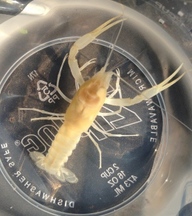Noteworthy
Burmese wild chickens in Fitzgerald are drawing new attention as the species, officially called red junglefowl, dwindles and scientists try to preserve its genetic integrity, according to Audubon magazine. Fitzgerald’s annual Wild Chicken Festival, a former rattlesnake roundup, celebrates the city’s free-ranging red junglefowl, remnants of failed government efforts to establish these poultry predecessors as a game bird in the South.
Ticks and prescribed fire don’t mix. New research suggests that long-term burning significantly reduced tick counts on study plots in southwest Georgia and northeast Florida, chalking up another benefit for prescribed fire, a critical tool for restoring and managing fire-adapted habitats.
 A Dougherty Plain cave crayfish has been caught in a monitoring well in Mitchell County, the first record of the subterranean species in that south Georgia county. Researchers contracting with DNR also recently caught two in Miller County, part of trapping to assess the status of the crayfish petitioned for federal listing (“Parting shot: Two rare crayfish,” Sept. 29).
Three endangered mollusks with wild names are the focus of a finalized recovery plan announced by the U.S. Fish and Wildlife Service. Although they have vanished from 90 percent or more of their historical ranges, the interrupted rocksnail, rough hornsnail and Georgia pigtoe mussel are endemic to the Coosa River drainage in Georgia and Alabama, with the pigtoe also found in a Coosa tributary in Tennessee.
A pathogen deadly to salamanders looms on the horizon. Following in the wake of the amphibian killer Batrachochytrium dendrobatidis (Bd), a related chytrid fungus, B.salamandrivorans has ravaged some European populations of fire salamanders and, while not documented in the U.S., could spread farther west through the pet trade, according to new research.
Wood-duck banding went like gang-busters this summer. The effort by DNR’s Game Management Section project marked its second-best season since 1983, banding 596 wood ducks.
Should there be a trout fishing season in Georgia? DNR’s Fisheries Management Section has scheduled two public scoping meetings to hear from the public about possibly about opening all trout streams to fishing year-round.
Three pairs of red-cockaded woodpeckers were moved recently from Apalachicola National Forest in Florida to the Joseph W. Jones Ecological Research Center at Ichauway. The center in south Georgia’s Baker County is a charter member of DNR’s Safe Harbor program for endangered red-cockaded woodpeckers and has seen its population grow from one male in 1999 to 26 family groups, largely through translocating more than 70 birds.
Four freshwater turtles native to the Southeast would be covered under the Convention on International Trade in Endangered Species of Wild Fauna and Flora (CITES) via a proposed federal rule. Common snapping, Florida softshell, smooth softshell and spiny softshell turtles are threatened by growing global trade in turtles, spurring the rule change aimed at improving monitoring, clarifying the legality of exports and helping determine whether more intense conservation is needed.
Names in the news: The Georgia Land Conservation Program’s new manager is Fuller Callaway. Previously land conservation specialist for the Georgia Conservancy, Callaway will guide the program’s mission to protect Georgia land and water resources and provide financing to local governments, conservation organizations and landowners for permanent land conservation.
Coming up:
Continuing through Nov. 14 – Joint Georgia and Southeastern Exotic Pest Plant Council annual conference and symposium, UGA conference center, Athens.
Nov. 15 – Right Whale Festival, Sea Walk Pavilion, Jacksonville Beach, Fla.
April 28-29 – 2015 Georgia Water Resources Conference, UGA Center for Continuing Education, Athens.
Back to top.
|
Headlines
"Right Whale Festival continues to be a beacon for endangered species," Florida Times-Union
"Mysterious fungal disease proves deadly in wild snakes," LiveScience.com
"Berry eagles readying for third breeding season, seem unfazed by construction near nest," Rome News-Tribune (and others via AP)
"Invasive species found on Cumberland," The Brunswick News
"The phenology of ticks and the effects of long-term prescribed burning on tick population dynamics in southwestern Georgia and northwestern Florida," PLOS ONE journal
"Hermit thrushes, humans share some musical basics," Science News (citing research in Proceedings of the National Academy of Sciences)
"Biologists work to preserve rare orchids," The Brunswick News
"Georgia shorebirds get a boost from surveillance cameras," Savannah Morning News and others, including The Albany Herald
"Stalking the wild ur-chicken," Audubon
"Hungry bats compete for prey by jamming sonar," Wake Forest University
"New frog species discovered in New York City," Science News (citing research in PLOS One)
"How to mend the conservation divide," The New York Times
Video
"Praying mantis hunting hummingbirds," YouTube
"Parks Canada video catches 1st black bear to use wildlife crossing," CBC/Radio-Canada
Credits:
** Masthead: Whooping crane takes off. Kim Mitchell/Whooping Crane Eastern Partnership
** Eastern towhee with an acorn. Terry W. Johnson
** Two banded whooping cranes. Kim Mitchell/Whooping Crane Eastern Partnership
** 2014 aircraft-led flock takes flight. Operation Migration
** Seining Raccoon Creek. Bill Harbin
** Sicklefin redhorse. Brett Albanese/Ga. DNR
** Dougherty Plain cave crayfish caught in Mitchell County monitoring well. Dr. Anna McKee/U.S. Geological Survey
Back to top.
|